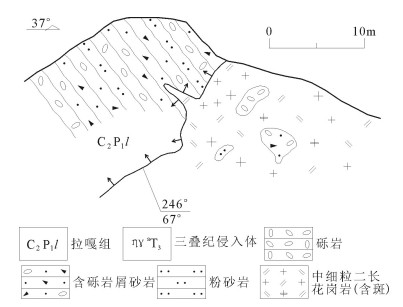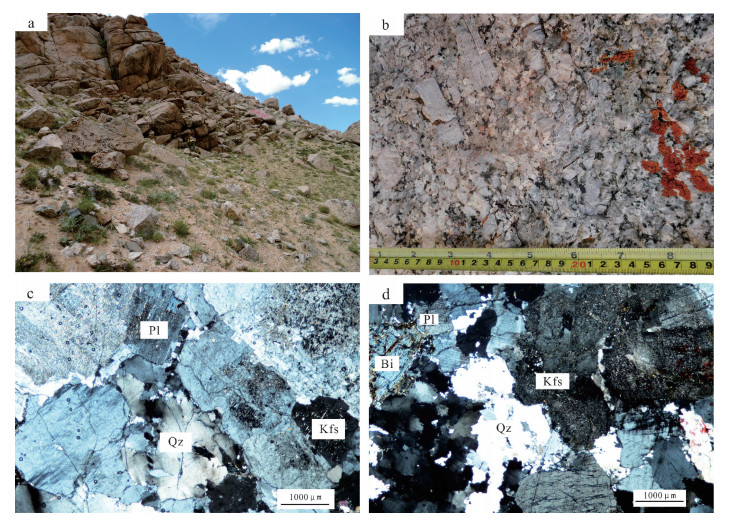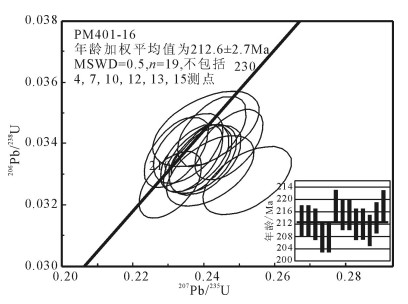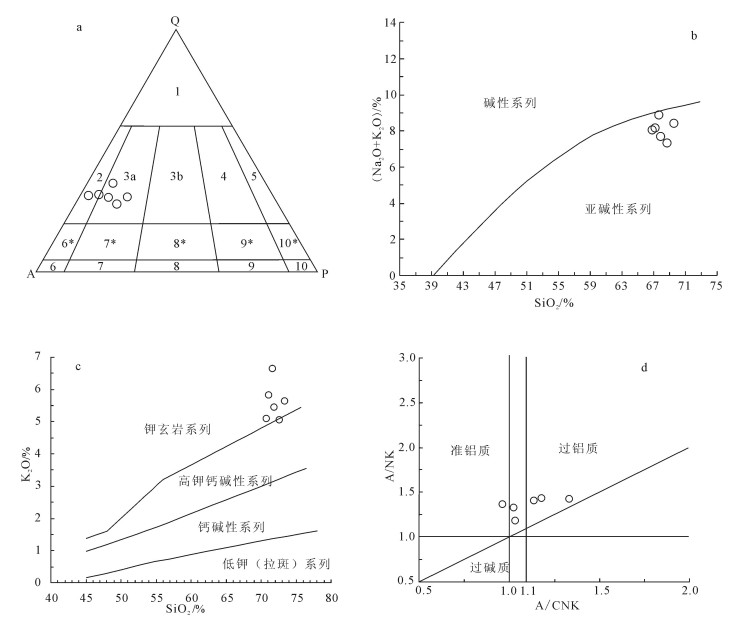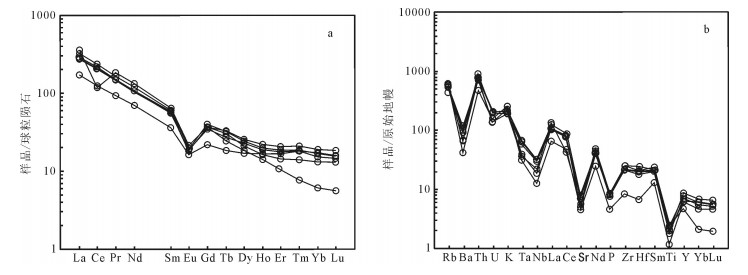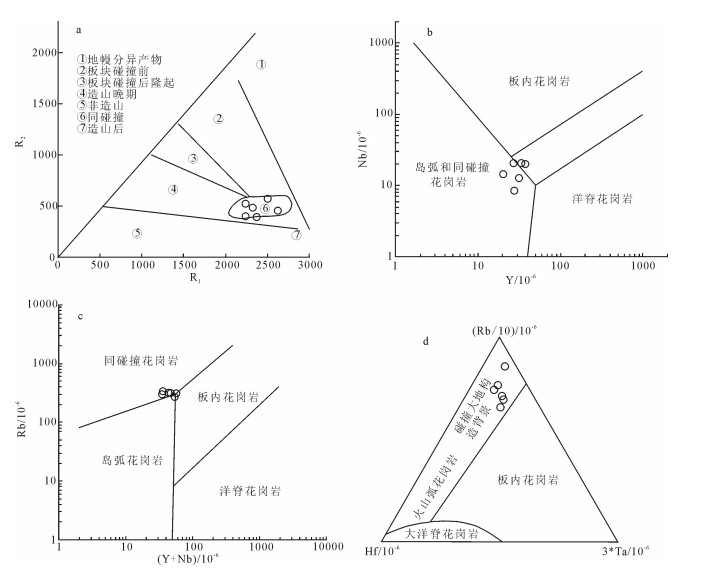Zircon U-Pb geochronology and petro-geochmistry of the Late Triassic coarse grained porphyaceous monzonitic granite in Cuolong Co, Tibet
-
摘要:
对出露于冈底斯中带偏西部错龙错地区原划为早白垩世的粗粒巨斑二长花岗岩进行了较系统的岩石学、LA-ICP-MS锆石U-Pb定年、地球化学研究。结果表明,该地区粗粒巨斑二长花岗岩的成岩年龄为212.6±2.7Ma,属晚三叠世。岩石为高钾钙碱性-钾玄岩系列,具高SiO2、K2O的特征。Al2O3含量为13.18%~16.26%,铝饱和指数A/CNK为0.96~1.33(平均值为1.11),为准铝质-过铝质花岗岩。稀土元素总量在182.99×10-6~324.34×10-6之间,轻稀土元素明显富集,重稀土元素相对亏损,δEu值变化于0.38~0.57之间,具明显的负Eu异常。微量元素富集K、Rb、Th和相对亏损Ba、Nb、Sr、P、Ti,具有类似造山后花岗岩的微量元素特征。该类岩石的地球动力学背景应为班公湖-怒江洋壳南向俯冲有关的由挤压向伸展转变的同碰撞向后碰撞的过渡阶段。
Abstract:Lithology, LA-ICP-MS zircon U-Pb age, and geochemistry of coarse grained porphyaceous monzonitic granite from Lower Cretaceous Cuolong Co area in the west of the middle Gangdise granitoid belt were studied in detail in this paper. The results show that magma zircons from coarse grained porphyaceous monzonitic granite yielded a weighted mean age of 212.6±2.7Ma, indicating Late Triassic. The rock is shoshonitic or high K calc-alkaline and relatively rich in Si2 and K2O. Al2O3 content is between 13.18% and 16.26%, A/CNK ratios vary from 0.96 to 1.33 (1.11 on average), displaying peraluminous characteristics. Total rare earth element values are between 182.99×10-6 and 324.34×10-6. Trace element ratio spider diagram displays apparent enrichment of light rare earth elements, depletion of heavy rare earth elements, δEu variation between 0.38 and 0.57, and sharp negative Eu anomalies. Trace elements are characterized by enrichment of K, Rb, Th and depletion of Ba, Nb, Sr, P, Ti, similar to features of orogenesis granite. Geodynamic analysis of rock background shows that it was most likely associated with a back-arc setting in response to conversion from compression to stretching related to the southward subduction of the Bangong Co-Nujiang oceanic lithosphere.
-
致谢: 感谢中国地质科学院国家地质实验测试中心对锆石U-Pb测年工作所作出的努力;感谢湖北省地质实验测试中心对本文地球化学数据进行分析;感谢野外工作及论文写作过程中提供指导和帮助的四川省地质调查院贾小川教授级高工、杨学俊和刘卫新高级工程师。
-
图 6 粗粒巨斑二长花岗岩稀土元素配分图(a)和微量元素蛛网图(b)[23]
Figure 6. Chondrite-normalized REE patterns(a) and primitive mantle-normalized trace element spidergram(b) of coarse grained porphyaceous monzonitic granite
图 8 粗粒巨斑二长花岗岩的Rb/Sr-Rb/Ba关系[29]
Figure 8. Relation of Rb/Sr-Rb/Ba of coarse grained porphyaceous monzonitic granite
表 1 粗粒巨斑二长花岗岩LA-ICP-MS锆石U-Th-Pb同位素分析结果
Table 1 LA-ICP-MS zircon U-Th-Pb data of coarse grained porphyaceous monzonitic granite
序号 207Pb*/206Pb* 207Pb*/235U 206Pb*/238U 208Pb/232Th 年龄/Ma Th/U 比值 ±1σ 比值 ±1σ 比值 ±1σ 比值 ±1σ 207Pb/
206Pb±1σ 207Pb/
206Pb±1σ 206Pb/
238U±1σ 208Pb/
232Th±1σ 1 0.05266 0.00115 0.2367 0.0058 0.03352 0.00073 0.01076 0.00021 314 51 216 5 213 5 216 4 0.19 2 0.05140 0.00124 0.2375 0.0064 0.03353 0.00073 0.01107 0.00024 259 57 216 5 213 5 223 5 0.18 3 0.05135 0.00122 0.2397 0.0064 0.03347 0.00073 0.01030 0.00022 257 56 218 5 212 5 207 4 0.19 4 0.05616 0.00121 0.2806 0.0067 0.03857 0.00084 0.0106 0.00021 459 49 251 5 244 5 213 4 0.17 5 0.05222 0.00119 0.2306 0.0058 0.03266 0.00072 0.01092 0.00022 295 53 211 5 207 4 220 4 0.23 6 0.05149 0.00147 0.2522 0.0083 0.03279 0.00073 0.01028 0.00025 263 67 228 7 208 5 207 5 0.21 7 0.06011 0.00146 0.2989 0.0082 0.03557 0.00079 0.01138 0.00022 608 54 266 6 225 5 229 4 0.68 8 0.05206 0.00123 0.2425 0.0064 0.03440 0.00076 0.01094 0.00022 288 55 220 5 218 5 220 4 0.26 9 0.05058 0.00123 0.2356 0.0065 0.03385 0.00075 0.01117 0.00024 222 58 215 5 215 5 225 5 0.19 10 0.05380 0.00112 0.2605 0.0061 0.04132 0.00091 0.00923 0.00018 363 48 235 5 261 6 186 4 0.16 11 0.05205 0.00119 0.2471 0.0064 0.03397 0.00076 0.01157 0.00024 288 53 224 5 215 5 233 5 0.18 12 0.05126 0.00116 0.2447 0.0063 0.03706 0.00083 0.00971 0.00022 253 53 222 5 235 5 195 4 0.12 13 0.05254 0.0011 0.2500 0.0059 0.03918 0.00087 0.01157 0.00022 309 49 227 5 248 5 233 4 0.16 14 0.05181 0.00122 0.2384 0.0064 0.03344 0.00075 0.01061 0.00022 277 55 217 5 212 5 213 4 0.22 15 0.05446 0.00117 0.2656 0.0064 0.03785 0.00084 0.01083 0.00021 390 49 239 5 239 5 218 4 0.15 16 0.05144 0.00124 0.2405 0.0066 0.03345 0.00075 0.00593 0.00012 261 57 219 5 212 5 120 2 0.41 17 0.05333 0.00157 0.2419 0.0082 0.03311 0.00076 0.01042 0.00024 343 68 220 7 210 5 210 5 0.31 18 0.05096 0.00116 0.2322 0.0060 0.03372 0.00076 0.01093 0.00022 239 54 212 5 214 5 220 4 0.18 19 0.05150 0.00185 0.2407 0.0099 0.03447 0.00081 0.01023 0.00033 263 84 219 8 218 5 206 7 0.18 注:Pb*代表放射成因铅 表 2 粗粒巨斑二长花岗岩主量、微量和稀土元素分析结果
Table 2 Major, trace and rare earth element analyses of coarse grained porphyaceous monzonitic granite
样品号 pm401-18H1 pm401-34H1 pm401-45H1 pm402-91H1 pm402-99H1 pm402-142H1 SiO2 70.35 69.9 71.33 69.63 70.84 72.11 TiO2 0.42 0.43 0.5 0.48 0.25 0.37 Al2O3 13.72 14.93 13.93 14.42 16.26 13.18 Fe2O3 0.74 0.59 0.64 0.8 0.5 0.56 FeO 1.7 1.85 2.15 2.07 0.98 1.8 MnO 0.05 0.04 0.05 0.04 0.02 0.03 MgO 0.67 0.73 0.86 0.79 0.47 0.61 CaO 2.34 1.4 1.18 1.75 0.45 0.9 Na2O 2.55 2.67 2.6 3.29 2.59 3.12 K2O 5.35 5.74 4.97 5.03 6.57 5.54 P2O5 0.15 0.17 0.15 0.17 0.09 0.16 H2O+ 1.04 1.26 1.36 1.09 0.72 1.16 CO2 0.73 0.08 0.08 0.11 0.04 0.11 烧失量 1.61 1.15 1.23 1.05 0.67 1.2 总量 101.41 100.94 101.03 100.73 100.45 100.84 La 64.54 68.05 76.31 76.31 64.54 68.05 Ce 123.26 130.43 143.92 143.92 123.26 130.43 Pr 13.52 14.14 15.46 15.46 13.52 14.14 Nd 47.81 50.18 54.85 54.85 47.81 50.18 Sm 8.68 8.87 9.2 9.2 8.68 8.87 Eu 1.04 1.23 1.11 1.11 1.04 1.23 Gd 7.51 7.57 8.15 8.15 7.51 7.57 Tb 1.24 1.13 1.22 1.22 1.24 1.13 Dy 6.53 5.39 6.16 6.16 6.53 5.39 Ho 1.24 0.92 1.12 1.12 1.24 0.92 Er 3.41 2.37 3.1 3.1 3.41 2.37 Tm 0.53 0.36 0.48 0.48 0.53 0.36 Yb 3.25 2.24 2.87 2.87 3.25 2.24 Lu 0.47 0.33 0.39 0.39 0.47 0.33 Y 37.6 26.69 33.63 33.63 37.6 26.69 ΣREE 283.04 293.21 324.34 324.34 283.04 293.21 (La/Yb)N 14.22 21.76 19.05 19.05 14.22 21.76 δEu 0.38 0.45 0.38 0.38 0.38 0.45 δCe 0.97 0.98 0.97 0.97 0.97 0.98 Co 5.15 5.6 5.77 5.76 2.52 4.62 Cu 2.17 3.21 12.07 6.91 5.58 4.43 Zn 56.45 32.96 54.83 55.02 33.31 46.62 Rb 305.1 312.9 271.1 295.2 335.4 317.5 Zr 223.99 231.01 261.14 265.3 90.39 223.9 Nb 19.73 20.5 20.7 14.38 8.52 12.53 Hf 5.83 6.05 7.02 6.1 2 5.2 Ta 2.15 2.49 2.37 1.37 1.2 1.5 Mo 0.39 0.38 0.29 0.59 0.35 0.41 W 2.56 1.29 1.84 1.58 1.22 1.55 Pb 65.41 66.89 57.56 55.38 80.77 68.85 Th 50.35 50.66 51.59 66.58 35.98 55.18 U 3.85 2.54 2.59 3.67 2.86 3.75 Cr 12.67 15.25 15.18 21.26 14.45 14.18 BaO 548 730 604.8 417.8 258.1 400.5 Ni 5.73 5.27 6.51 5.41 3.25 3.93 Sr 140.1 159.2 148.8 111.2 85.96 97.89 V 33.14 36.48 40.66 37.98 13.59 27.91 As 2.46 1.55 1.42 1.47 1.01 0.86 Sb 0.21 0.29 0.23 0.21 0.14 0.16 Sn 8.28 6.76 10.26 4.79 3.66 6.26 Ag 0.052 0.041 0.039 0.045 0.028 0.102 Au 0.3 0.3 0.3 0.2 0.5 0.3 注:主量元素含量单位为%,稀土和微量元素单位为10-6;分析测试单位为湖北省地质实验测试中心 -
莫宣学, 董国臣, 赵志丹, 等.西藏冈底斯带花岗岩的时空分布特征及地壳生长演化信息[J].高校地质学报, 2005, 11(3):281-290. http://kns.cnki.net/KCMS/detail/detail.aspx?filename=gxdx200503001&dbname=CJFD&dbcode=CJFQ Coulon C, Maluski H, Bollinger C, et al. Mesozoic and cen-ozoic volcanic rocks from central andsouthern Tibet:39Ar-40Ar dating, petrological characteristics and geodynamicla significance[J]. Annual Review of Earth and Planetary Science Letters, 1986, 79:281-302. doi: 10.1016/0012-821X(86)90186-X
Mo X X, Hou Z Q, Niu Y L, et al. Mantle contributions to crustal thickening during continental collision:Evidence from Cenozoic igneous rocks in southern Tibet[J]. Lithos, 2007, 96:225-242. doi: 10.1016/j.lithos.2006.10.005
Harris N, Inger S, Xu R H. Cretaceous plutonism in Central Tibet:an example of post-collision magmatism[J]. Journal of Volcanology and Geothermal Research, 1990, 44:21-32. doi: 10.1016/0377-0273(90)90009-5
Zhu D C, Mo X X, Niu Y L, et al. Geochemical investigation of Early Cretaceous igneous rocks along an east-west traverse throughout the central Lhasa Terrane, Tibet[J]. Chemical Geology, 2009, 268:298-312. doi: 10.1016/j.chemgeo.2009.09.008
Zhu D C, Mo X X, Wang L Q, et al. Petrogenesis of highly fractionated Ⅰ-type granites in the Zayuarea of eastern Gangdese, Tibet:Constraints from zircon U-Pb geochronology, geochemistry and Sr-Nd-Hf isotopes[J]. Science in China(Series D), 2009, 52:1223-1239. doi: 10.1007/s11430-009-0132-x
Zhu D C, Mo X X, Niu Y L, et al. Zircon U-Pb dating and insitu Hf isotopic analysis of Permian peraluminous granite in the Lhasa terrane, southern Tibet:Implications for Permian collisional orogeny and paleogeography[J]. Tectonophysics, 2009, 469:48-60. doi: 10.1016/j.tecto.2009.01.017
王程, 魏启荣, 刘小念, 等.冈底斯印支晚期后碰撞花岗岩:锆石U-Pb年代学及岩石地球化学证据[J].地球科学, 2014, 39(9):1277-1300. http://d.wanfangdata.com.cn/Periodical/dqkx201409003 李化启, 蔡志慧, 陈松永, 等.拉萨地体中的印支造山事件及年代学证据.岩石学报, 2008, 24(7):1595-1604. http://kns.cnki.net/KCMS/detail/detail.aspx?filename=ysxb200807016&dbname=CJFD&dbcode=CJFQ 张宏飞, 徐旺春, 郭建秋, 等.冈底斯印支期造山事件:花岗岩类锆石U-Pb年代学和岩石成因证据[J].地球科学, 2007, 32(2):155-166. http://www.cqvip.com/QK/94035X/20072/25941443.html 和钟铧, 杨德明, 郑常青, 等.冈底斯带门巴花岗岩同位素测年及其对新特提斯洋俯冲时代的约束[J].地质论评, 2006, 52(1):100-106. http://kns.cnki.net/KCMS/detail/detail.aspx?filename=dzlp200601016&dbname=CJFD&dbcode=CJFQ 李才, 王天武, 李惠民, 等.冈底斯地区发现印支期巨斑花岗闪长岩古冈底斯造山的存在证据[J].地质通报, 2003, 22(5):364-366. http://dzhtb.cgs.cn/ch/reader/view_abstract.aspx?file_no=20030568&flag=1 宋绍玮, 刘泽, 朱弟成, 等.西藏打加错晚三叠世安山质岩浆作用的锆石U-Pb年代学和Hf同位素[J].岩石学报, 2014, 30(10):3100-3112. http://kns.cnki.net/KCMS/detail/detail.aspx?filename=ysxb201410023&dbname=CJFD&dbcode=CJFQ 朱弟成, 潘桂棠, 王立全, 等.西藏冈底斯带中生代岩浆岩的时空分布和相关问题的讨论[J].地质通报, 2008, 27(9):1535-1550. http://dzhtb.cgs.cn/ch/reader/view_abstract.aspx?file_no=20080913&flag=1 潘桂棠, 莫宣学, 侯增谦, 等.冈底斯造山带的时空结构及演化[J].岩石学报, 2006, 22:521-533. http://d.wanfangdata.com.cn/Periodical/ysxb98200603001 侯可军, 李延河, 田有荣. LA-MC-ICP-MS锆石微区原位UPb定年技术[J].地质矿产, 2009, 28(4):481-492. http://d.wanfangdata.com.cn/Periodical/kcdz200904010 Ludwig K R. Users manual for isoplot 3.0:A geochronological toolkit for Microsoft excel. Berkeley[J]. Berkeley Geochronology Center Special Publication, 2003:1-71.
Hoskin P W O, Schaltegger U. The composition of Zircon and Igneous and Metamorphic Petrogenesis[J]. Rev. Miner. Geochem, 2003, 53(1):27-62. doi: 10.2113/0530027
Maitre R W L. A Classification of Igneous Rocks and Glossary of Terms[M]. Blackwell Scientific Publications, 1989.
Peccerillo R, Taylor S R. Geochemistry of eocene calc- alkaline volcanic rocks from the Kastamonu area, Northern Turkey[J]. Contrib. Mineral Petrol., 1976, 58:63-81. doi: 10.1007/BF00384745
Maniar P D, Piccolli P M. Tectonic discrimination of granitoid[J]. Geol. Soc. Am. Bull., 1989, 101:635-643. doi: 10.1130/0016-7606(1989)101<0635:TDOG>2.3.CO;2
Barbarin B. A review of the ralationships between granitoid types, their origins and their geodynamic environments[J]. Lithos, 1999, 46:605-626. doi: 10.1016/S0024-4937(98)00085-1
Sun S S, Mcdonough W F. Chemical and isotopic systematics of oceanic basalts:Implications for mantle composition and processes[J]. Geological Society of London Special Publications, 1989, 42(1):313-345. doi: 10.1144/GSL.SP.1989.042.01.19
Vinogradov A P. Average content of chemical elements in the chief types of igneous rocks of the crust of the Earth[J].Geokhimia, 1962, (7):555-571(in Russian with English abstract).
张旗, 潘国强, 李承东, 等.花岗岩构造环境问题:关于花岗岩研究的思考之三[J].岩石学报, 2007, 23(11):2683-2698. doi: 10.3969/j.issn.1000-0569.2007.11.002 Batchelor R A, Bowden P. Petrogenetic Interpretation of Granitoid Rock Series Using Multicationic Parameters[J]. Chemical Geology, 1985, 48(1/4):43-55. http://www.sciencedirect.com/science/article/pii/0009254185900348
Pearce A J A, Harris N B W, Tindle A G. Trace- element discrimination diagrams for the tectonic interpretation of granitic rocks[J]. J. Petrol., 1984, 25(4):956-983. doi: 10.1093/petrology/25.4.956
Liegeoiset J P. Some words on the post-collisional magmatism[J]. Lithos, 1998, 45:ⅩⅤ-ⅩⅦ.
Sylvester L. Post-collisional strongly peraluminous granites[J]. Lithos, 1998, 45:29-44. doi: 10.1016/S0024-4937(98)00024-3
耿全如, 潘桂棠, 金振名, 等.西藏冈底斯叶巴组火山岩地球化学及成因[J].地球科学-中国地质大学学报, 2005, 30(6):747-760. http://www.cqvip.com/QK/94035X/20056/20589036.html 潘桂棠, 莫宣学, 侯增谦, 等.冈底斯造山带的时空结构及演化[J].岩石学报, 2006, 22(3):521-533. http://d.wanfangdata.com.cn/Periodical/ysxb98200603001 王立全, 潘桂棠, 朱弟成, 等.西藏冈底斯带石炭-二叠纪岛弧造山作用:火山岩及地球化学证据[J].地质通报, 2008, 27(9):1509-1534. http://dzhtb.cgs.cn/ch/reader/view_abstract.aspx?file_no=20080912&flag=1 朱弟成, 莫宣学, 赵志丹, 等.西藏南部二叠纪和早白垩世构造岩浆作用与特提斯演化:新观点[J].地学前缘, 2009, 16(2):1-20. http://kns.cnki.net/KCMS/detail/detail.aspx?filename=dxqy200902002&dbname=CJFD&dbcode=CJFQ 李才, 王天武, 李惠民, 等.冈底斯地区发现印支期巨斑花岗闪长岩:古冈底斯造山的存在证据[J].地质通报, 2003, 22(5):364-366. http://dzhtb.cgs.cn/ch/reader/view_abstract.aspx?file_no=20030568&flag=1 卜涛, 魏启荣, 丁鹏飞, 等.西藏冈底斯带中段南木林县仁堆侵入体LA-ICP-MS锆石U-Pb年龄及岩石成因[J].地质通报, 2015, 34(12):2254-2265. doi: 10.3969/j.issn.1671-2552.2015.12.012 廖忠礼, 莫宣学, 潘桂棠, 等.初论西藏过铝花岗岩[J].地质通报, 2006, 25(7):812-821. http://dzhtb.cgs.cn/ch/reader/view_abstract.aspx?file_no=200607147&flag=1 谢国刚, 郝爰健, 袁建芽, 等. 1: 25万区域地质调查(邦多幅). 江西省地质调查院, 2002.



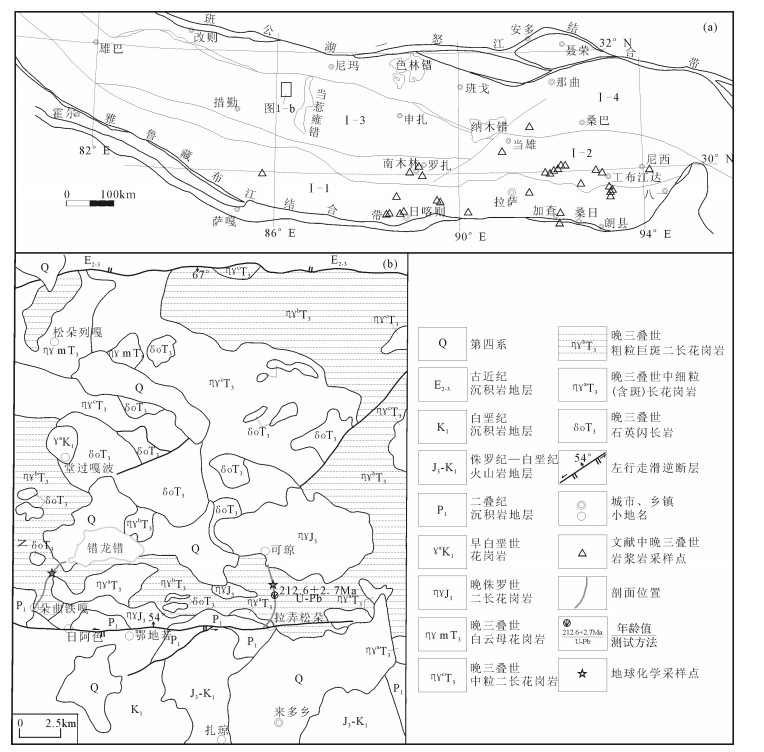
 下载:
下载:
